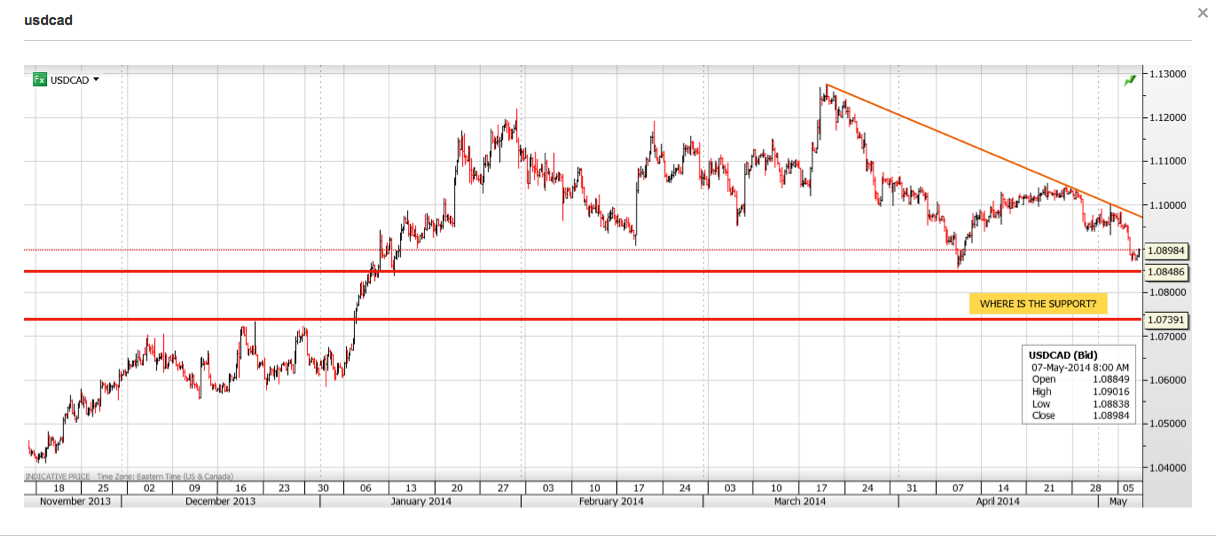- "Wheel-ers" come off bus in Kiwi
- Yellen expected to maintain doveish outlook
- FX markets turn blind eye to Ukraine conflict
The Reserve Bank of New Zealand governor, Graeme Wheeler, upped the ante on exchange rate talk, threatening to intervene in currency markets and sell New Zealand dollars. The criteria for such action would be if the currency remained elevated in the face of worsening fundamentals. The slight rise in NZ unemployment to 6.0 percent spooked traders, and NZD/USD dropped more than 1 percent. Wheeler may be reading from the Reserve Bank of Australia's playbook by attempting to add an element of two-way risk to the currency, especially since domestic rates are expected to rise another 2 percent, which has fuelled the NZD-USD rally.
Yellen in Congress spotlight
All ears and a few eyes will be on the US Federal Reserve chairman Janet Yellen's testimony to the US Senate's Joint Economic Committee this afternoon. The US dollar has lost ground against all the majors over the past week, in part due to the belief that Yellen will maintain a doveish outlook for the US economy. However, this view may be tainted if you consider that the combination of low volatility and leverage foster an environment in which even the "median" view can have powerful effects. This was suggested by the Federal Reserve governor Jeremy Stein's speech yesterday. He implied that highly leveraged positions can have outsized effects on markets despite the Federal Open Market Committee's best efforts at communication. The speech is well worth reading. In any event, the point is that, just as FX markets became overly optimistic on the onset of tightening, it may be overly pessimistic on Yellen's doveishness.
FX markets ignore rising geopolitical tensions
Back in the day, geopolitical tensions and a rising US dollar went hand-in-hand. When the dirt would hit the fan, the greenback was in demand. While that relationship may not be divorced it certainly looks as if it is having a trial separation. Russia, Ukraine and the "new" G7 are ratcheting up the rhetoric and parading the big guns over Russia's annexation of Crimea. FX traders bought EUR/USD even though one would think that Europe was far closer and more vulnerable to an escalation of the crisis than the United States. China, not content to just pick a fight with Japan over uninhabited rocks, has deployed a giant oil rig in the South China Sea in Vietnamese territorial waters. A Chinese vessel reportedly rammed two Vietnamese ships and the fact that the ramming vessel had air support suggests that the accident may have been pre-planned. China is also at odds with the Philippines, Taiwan and Malaysia. Libya hasn't recovered from the overthrow of Gadaffi, Egypt is a mess, Syria is still gassing its citizens and Iran wants nukes. Despite all this turmoil and evidence that the US economic recovery is accelerating, the US dollar is depressed.
Current loonie rally has longer to go
The Canadian dollar is the only G10 currency to have lost ground against the US dollar in 2014 implying that the current loonie rally may have farther to go. The bearish USD/CAD view is supported by: a) improving Canadian economic fundamentals highlighted by both trade and budget surpluses and improving GDP; b) elevated WTI prices and a shrinking WTI/WCS spread (West Texas Intermediate/Western Canada Select); c) broad-based US dollar weakness and d) improving outlook for the US economy.
The bullish USD/CAD view centres on the perception that the Bank of Canada (BoC) is concerned about slow export growth and prefers a weaker currency. The BoC governor's comments about "cutting rates" put a negative spin on the currency, even if the probability of a cut occurring was extremely remote. The expectation of Canadian economic growth lagging that of the US is another driver of negative sentiment. However, the trend is your friend. In the short term, the mix of general US dollar weakness against the majors, a doveish Janet Yellen and the possibility of an upward surprise to the Canadian employment data on Friday could lead to further USD/CAD losses and a test of 1.0700-50.
USDX, EURCAD, GBPCAD say USDCAD downside limited.
The US dollar index is down but still trading above key support in the 78.70-79.00 area which needs to break to argue for a deeper US dollar sell-off. Having said that, the intraday technicals support further downside. Both EUR/CADand GBP/CAD are trading above support and until these up trends reverse, Canadian dollar gains will be slow.

Source: Saxo Bank
USD/CAD technicals
The intraday USD/CAD technicals are bearish while trading below 1.0905 while the short-term technicals are bearish below 1.0960, which suggests additional probes of the 1.0850 support area. 1.0850 represents both a previous triple top and the 61.8 percent retracement of the 2014 range. There isn't much in the way of support between 1.0850 and 1.0740, meaning a break of 1.0850 could be painful for long USD/CAD positions.

Source: Saxo Bank
-- Edited by Kevin McIndoe
Michael O’Neill, of FX Consultant / IFXA Ltd, is an experienced trader, sales manager and FX portfolio manager.
